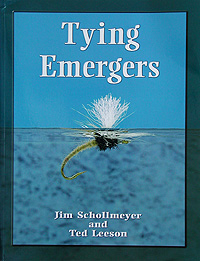In a desire to know more about tying emergers inlcuding the use of CDC feathers, I recently acquired this book. What a truely excellent book. Schollmeyer and Lesson have produced a thoroughly researched, documented and presented book on the subject of tying emergers. 344 pages on tying emegers and 20 pages alone on tying shucks/tails. The book smartly clusters hundreds of emerger patterns into several emerger style types (tuff wings, hackle, downwing, para etc), allowing one to really understand how the fly tying style and material positioning (e.g. parawing) determines how the emerger is fished and tied. I agree with authors that "the virtue of this arrangement is that it roups together flies that are generally simialr in appearence, allowing tyers to become acquainted with variations of a basic design" (page 19). At the start of each emerger type, the authors clearly explains how the specific style of emerger, how it is positioned in the water and its contribution to emerger fishing. As you would expect therefore, you quickly learn the effect of materials on fly design and fishing style. Full dressings are provided along with a short bio and then followed by a clear and easy to follow sequenced step by step instruction how to tie the fly. All the photographs are excellent. There are very informative insights at the start of the book on materials, hooks and tying techniques. This is very much about a book on tying techniques as well as emergers patterns and therefore simply not a pattern reference book. Many of the techniques learned from the book can be used to tie dries and nymphs. Is this US biased? I am not sure. A large numbers are from the US; whether this reflects a bias or not, I am not sure. There are a few UK stillwater emergers that UK tyers will be familar with such as the Shuttlecock emerger and some CDC patterns but many of the patterns are US orgin. You will not find Shipmans buzzer or Bob's bits in this book. Thus, there will be greater familiarty by US tyers to the patterns and originators, obviously. The book therefore will expose the UK tyer to a wealth of unknown patterns associated with insects commonly found in British waters such as midge, sedge and mayfly. I cannot recommend this book highly enough. A joy to read, own and cherish. This has to be one of the most authoritative books in the area. |
Friday, 1 October 2010
A must read!
Subscribe to:
Post Comments (Atom)

No comments:
Post a Comment